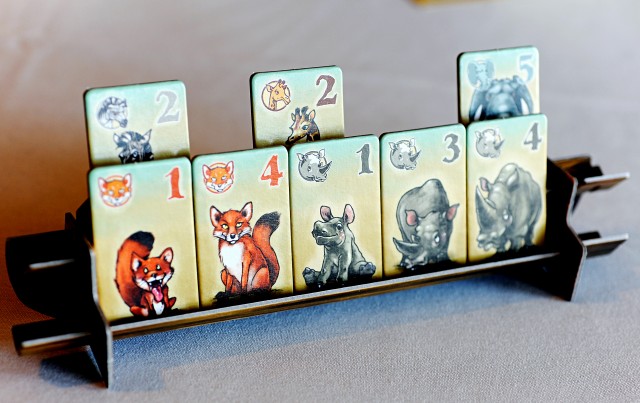One great lesson for kids to learn when they’re growing up is the concept of ‘I cut, you choose.’ This is the idea that if you have something that needs to be divided there will be a natural desire for all parties to want to get the biggest portion. If the person doing the splitting is the last to choose, they will have incentive to make all the portions as equal as possible. It’s a simple trick to find equitable solutions to different disputes. Just like many of life’s lessons, ‘I cut, you choose’ is a mechanic that shows up in a lot of games. Animals On Board is one of the latest to take advantage.
Now you’ve probably heard about a fabled flood and a boat captain collecting two of every animal for his ark, but that’s just silliness. In Animals On Board you’re looking to gather a single animal or groups of three or more, never just a pair.
There are sixty animal tiles; twelve different types of animals and five of each of the different types. All the animals from the rhinos to the tigers to the camels are numbered 1-5 in their respective sets and the art adorably follows the . Each player is vying to collect sets of animals for their own boat and stop their opponents from getting a good collection themselves.
Single animals are worth their face value. Groups of three or more of the same animal score five points for each one, but don’t get caught with only two. Pairs are worth nothing, so you have to make sure not to end up with only two of the same.
 Each round starts with a grouping of animals available. A full four player game will have thirteen animals to start. Twelve are face up showing you the value and type of animal. One is face down as a mystery animal. In turn the players choose to either split the group earning a food crate for their efforts or take a group of animals paying food crates equal to their cost. Each round players can only take one grouping placing the animals on their boat (with space for ten animals). Once they’ve take their group, they’re out for the round. The first player to exit a round is the first one to start the next round.
Each round starts with a grouping of animals available. A full four player game will have thirteen animals to start. Twelve are face up showing you the value and type of animal. One is face down as a mystery animal. In turn the players choose to either split the group earning a food crate for their efforts or take a group of animals paying food crates equal to their cost. Each round players can only take one grouping placing the animals on their boat (with space for ten animals). Once they’ve take their group, they’re out for the round. The first player to exit a round is the first one to start the next round.
As you can imagine, early in rounds there’s not a lot of people who can afford groups of thirteen, but the pack can be split in anyway and as many times as possible to form new sets and here’s where the real tough decisions come into play. The animals on your boat are technically secret, but it’s not that hard to keep track of what other people are looking for. You can choose to divide the pack in such a way that they can’t afford the set with the animal(s) they really want or separate those animals entirely, forcing them to choose to take them alone or hold out for a better haul. The last player in a round gets one final turn to either buy a group or split. They still earn their food crate if they decide not to select any group.
Animals On Board ends on the round when someone fills up their boat completely. The ten animals trigger game end, but players aren’t limited to that number if they can afford a group that will put them past that threshold, however for final scoring they will have to reduce their boat to only ten animals. Players earn points for the groups they’ve collected, minus pairs, with one additional point for every food crate they have left over.
Now, I really like this game. It’s fairly simple with nice art and components and plays out in about 30 minutes. I am a big fan of Piece O’ Cake and this game might just use the ‘I cut, you choose’ mechanic even better. It’s simple to teach as well and I think the puzzle will appeal to players of all skill levels. I wouldn’t quite put it in the must buy category for every player, but definitely if you like these interesting dilemma games then check it out. It can be a heck of a lot of fun to see your ark start to take shape while trying to upset the balance of your opponent’s boats. The clouds are forming and the tides are rising. Time to get on the boat or be left behind.
Comments
No comments yet! Be the first!